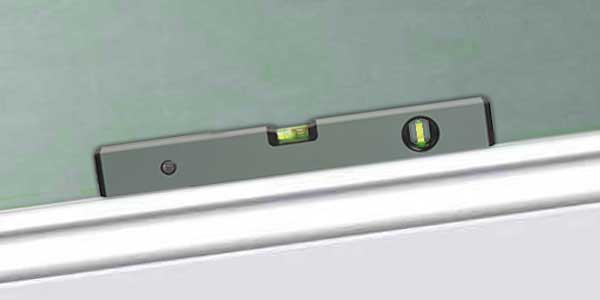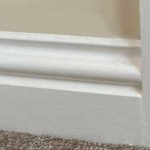When fitting skirting boards, it is not uncommon to be working on an uneven or sloping floor. This can happen for a variety of reasons; a few examples can be seen below:
- Deliberate slopes or changes in level
- Movement in floor joists over time
- Poorly laid flooring such as tiles or laminate
- Subsidence
These are just a couple of reasons your floor might be unlevel or uneven. Also, the amount of discrepancy can vary. This can be anything from small slopes or bellies in the floor, to big obvious drops in level.
Whatever the issue, a common question people ask, is does the skirting have to be level? Or can you just run the boards with the floor?
In an ideal world you would run your skirting boards level. However, if your floor is sloping, the boards should generally run at the same level as the floor. A small discrepancy in level will not be seen by the naked eye. But if your skirting runs at a slightly different level to the floor, it will be quite noticeable.
For uneven floors you have a couple of options including scribing the bottom of the boards, pushing the boards down to fill small gaps, or even leveling the floor.
Fitting skirting on a sloping floor

The first issue we are going to look at is a sloping floor. This is quite common especially in older period properties. The slopes will often be the result of natural movement over the years.
For example, let’s consider a Victorian terraced house, these properties are over 100 years old. During this time, it is not surprising there would have been some structural movement. In most cases this will be nothing to worry about, but it may cause slopes on your flooring.
Also, in some instances a slope may even be deliberate. Whatever the reason, you will want to make sure, that your new skirting board is fitted correctly, to give the right aesthetic appearance.
When it comes to sloping floors, it is generally recommended to run your skirting board with the floor. Ask your self the question, is it obvious the floor slopes, without using a level? If the answer is no, then you shouldn’t notice it with the skirting either.
If the issue is very obvious, due to a big slope, it may be wise to investigate. Perhaps you have damaged joists, or some other structural issues that need rectifying. If not and this is caused by natural movement or even a deliberate slope, you should just run the skirting with the floor.
If you do run your skirting level, on an unlevel floor, it is going to be obvious, especially if there is a significant difference. Anyone looking at the area, will be able to see the floor and skirting are running at different levels.
Not only that, but you will have a gap below one end of your skirting. This will affect any scribes or mitres on boards running perpendicular to this board.
Fitting skirting on an uneven floor
Fitting skirting on an uneven floor is a slightly different issue. This will usually mean you have bumps or bellies below your board. A bump would be pushing the board up and a belly would be leaving a gap below.
How you deal with these, will depend on their location and their severity. When it comes to very small uneven areas you can often push the boards down to fit flush with the floor. This can usually be done and not be obvious.
Also, if you are fitting carpets, very small gaps will be hidden and might be worth leaving.
For larger issues, or when you are fitting skirting above laminate or floor tiles (this won’t be hidden like carpets) you can scribe the bottom of your boards. This will involve marking uneven areas on the bottom of the board and then using a block plane to fit it to the floor.
You can see a simple explainer video of how this is done quite easily below:
Self-levelling before skirting
One other option you have on solid floors, is to level the floor with a self-levelling compound. This is a relatively simple DIY project and will mean you don’t need to worry about an uneven floor anymore.
Self-levelling can be bought at any builder’s merchant or DIY store and is easy to mix and apply. Simply follow instructions on the bag, for the amount of water needed, mix thoroughly and then apply to the surface.
You will need to move the mix around with a trowel to distribute it fairly evenly. However, following this the compound will find its own level (hence the name). After this has been left to completely go off, you will have a nice even and level floor to work off.
Need help fitting your skirting?
If you are finding the process a little daunting, or perhaps you are not confident you will get the best finish, you could seek the help of a professional.
This is quite a simple job for a skilled joiner. Therefore, you will easily find someone who can do the work to a very high standard at a reasonable cost.
The best way to hire for this type of work is via comparison websites. These offer several major advantages:
- All the joiners will be fully qualified
- They will be approved and verified by the comparison site
- You can see past jobs and customer reviews
- And the prices are cheaper as multiple people/businesses will be competing for the work.
We have seen discounts as high as 50% when hiring through this type of website. Also, because of the verification process and customer reviews, you know your hiring a good quality tradesman and not a cowboy.
Conclusion
As with most jobs, there is no one size fits all answer, for whether your skirting has to be level. In an ideal world it would be fit level. However, there are many reasons your floor could be uneven or slightly sloping.
The main goal is that it looks good, the finished aesthetic, is more important than the boards being 100% level.
As this article demonstrates there are several solutions depending on the exact issue you are facing.



